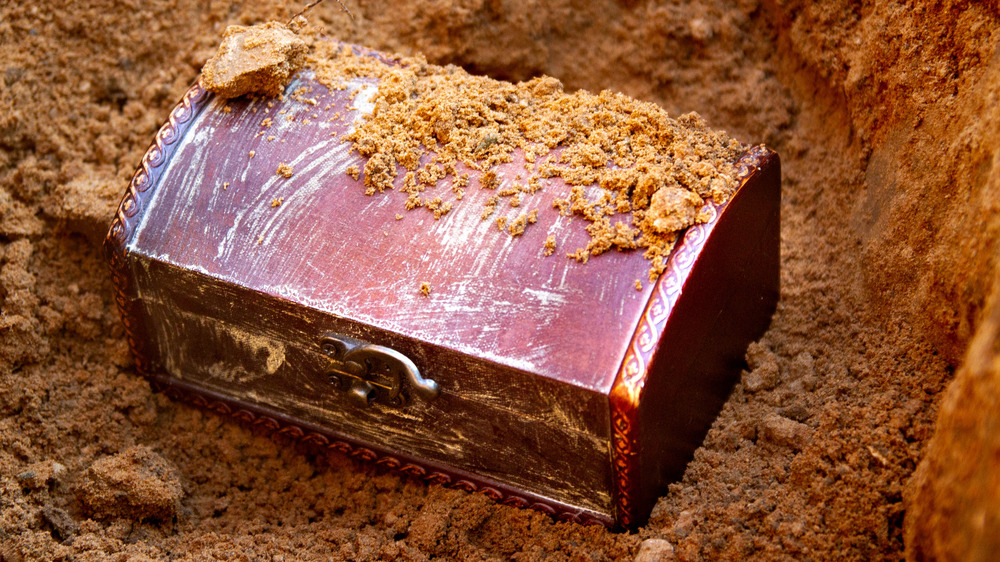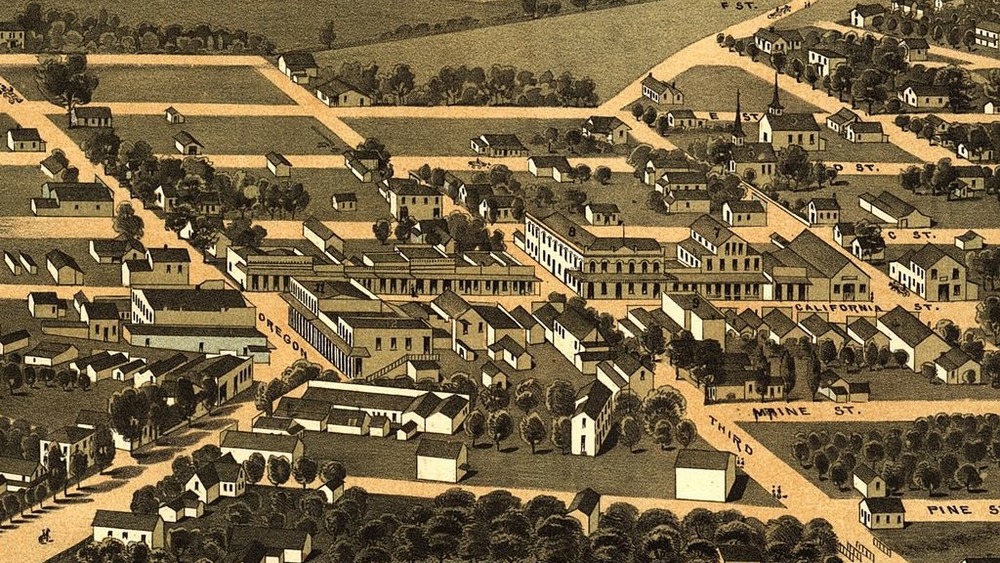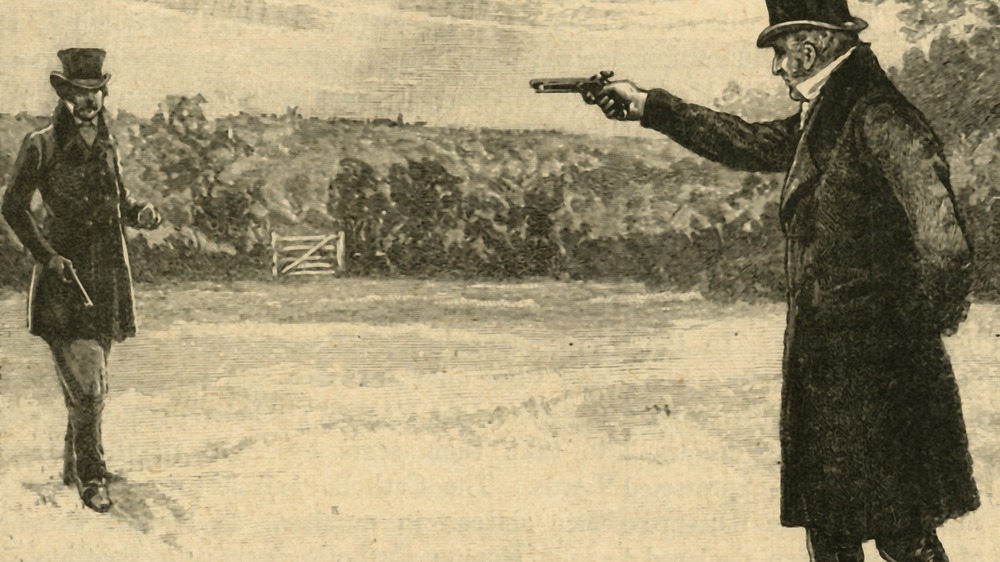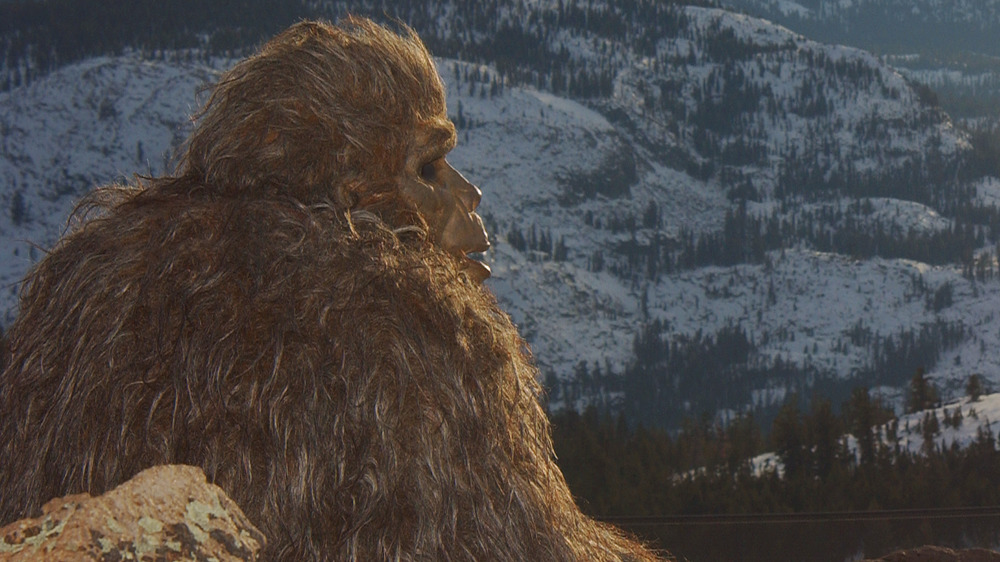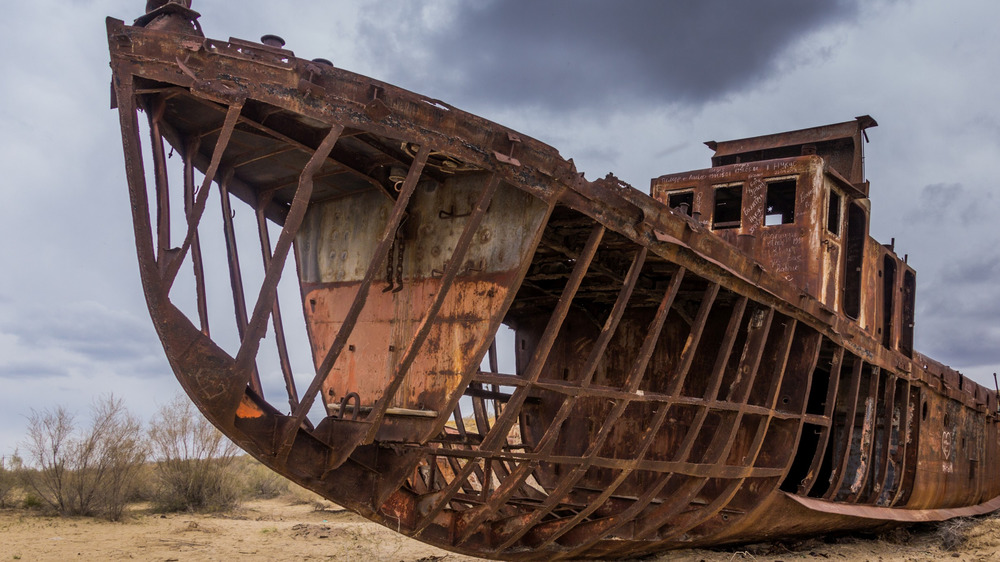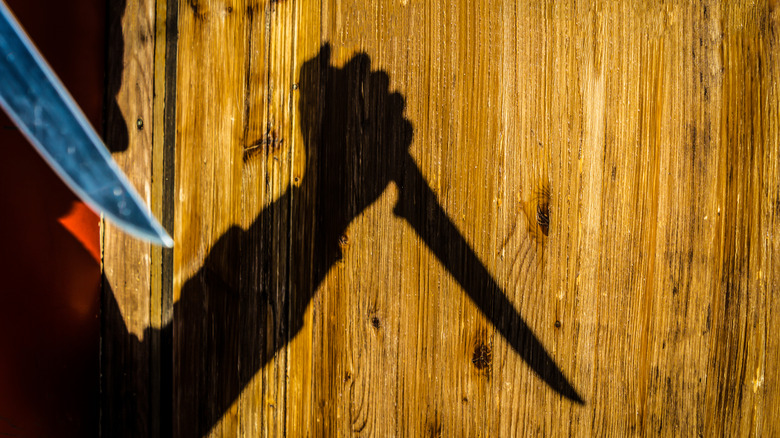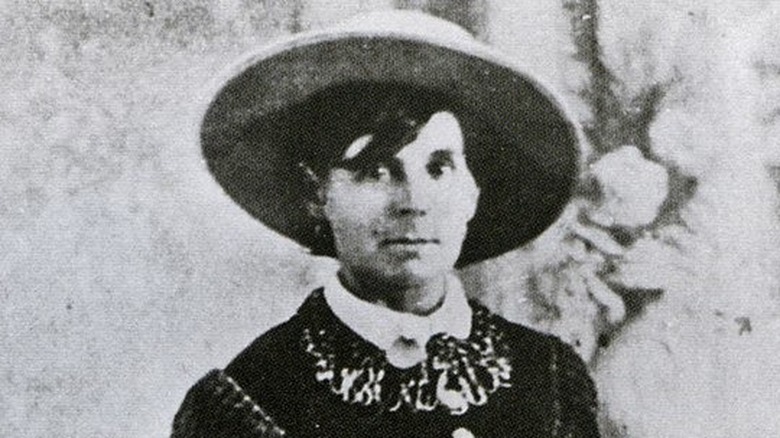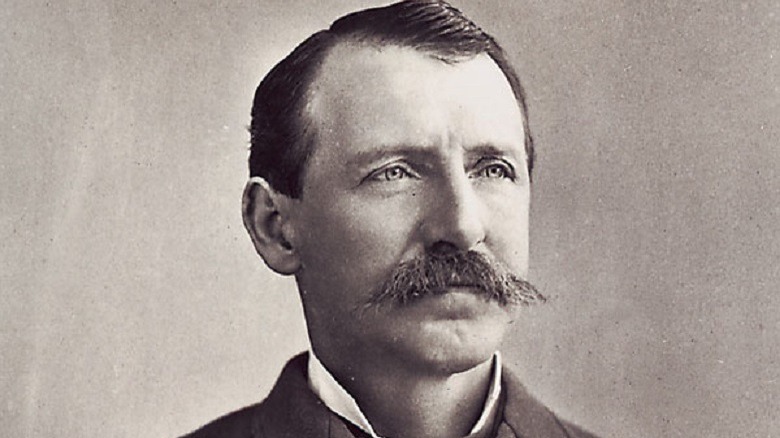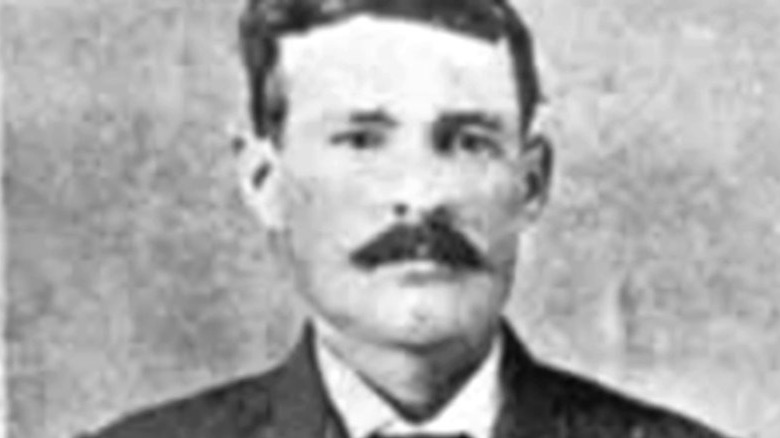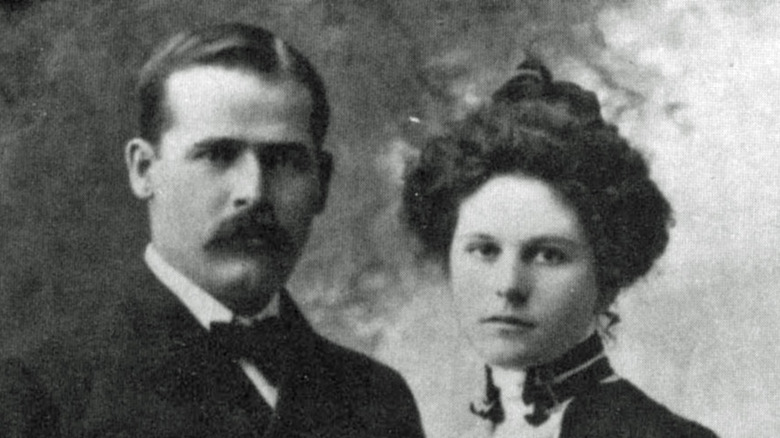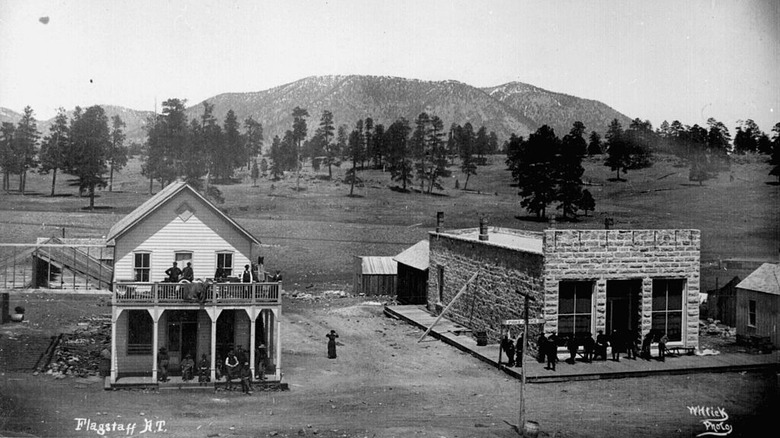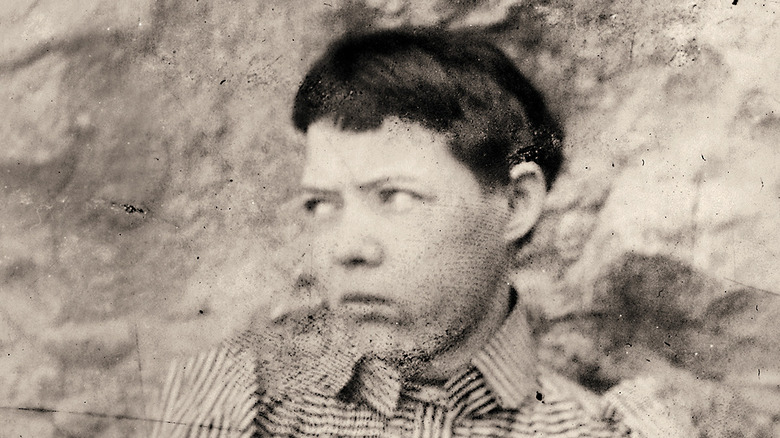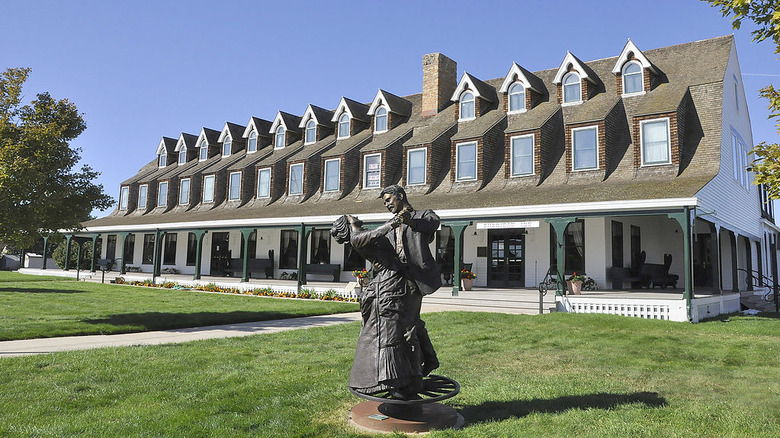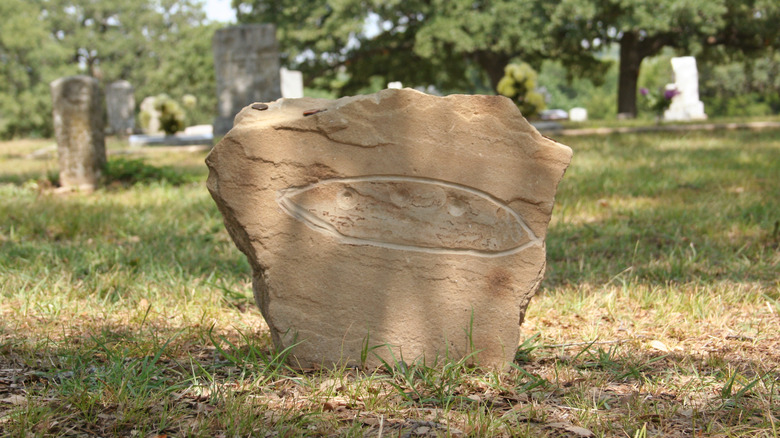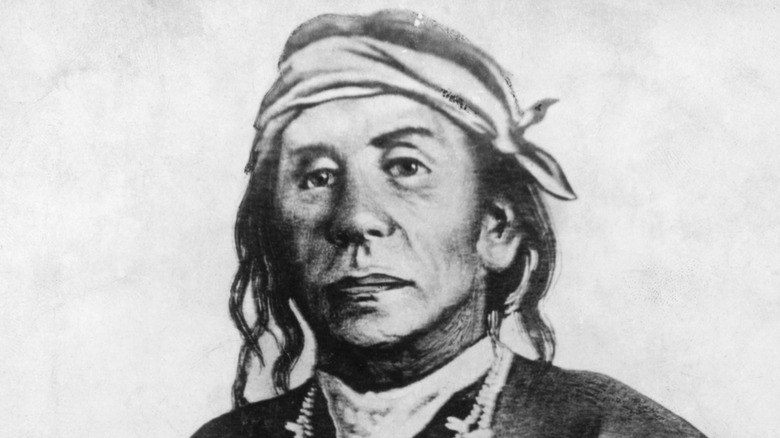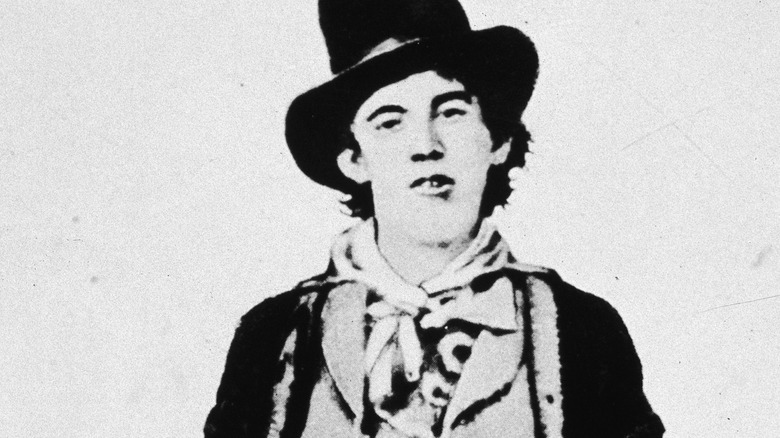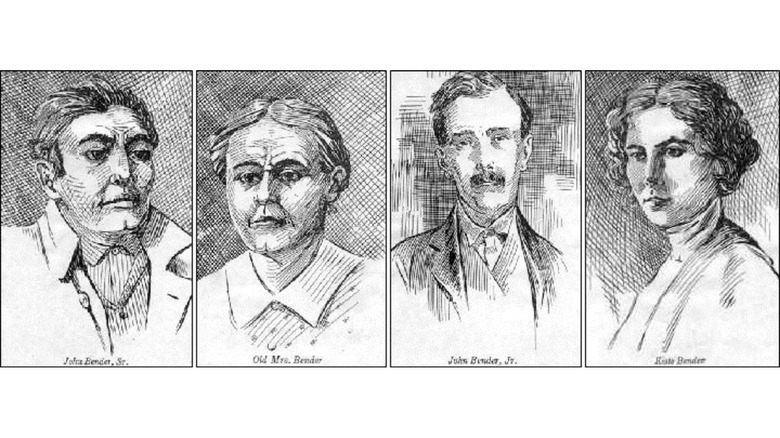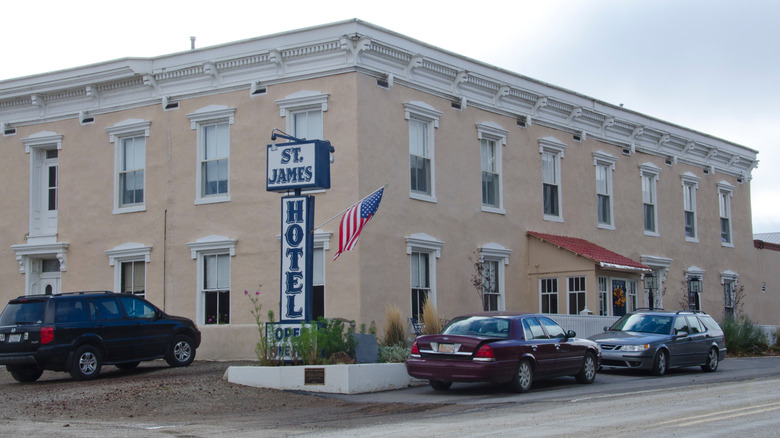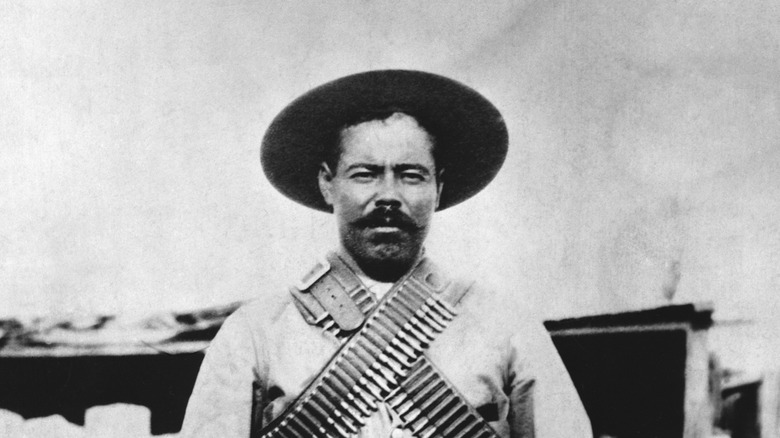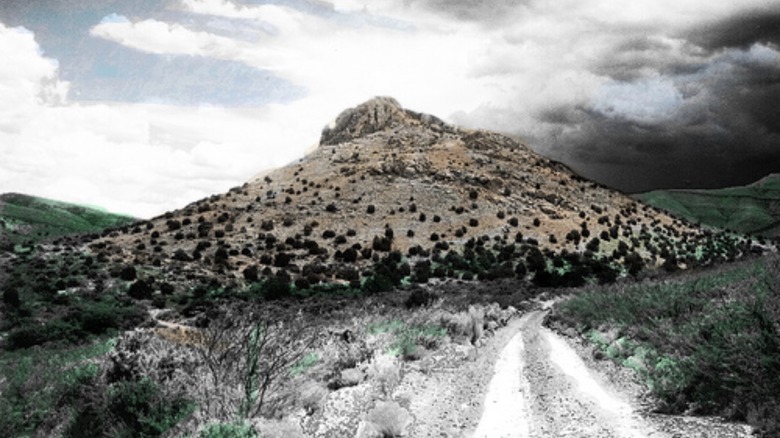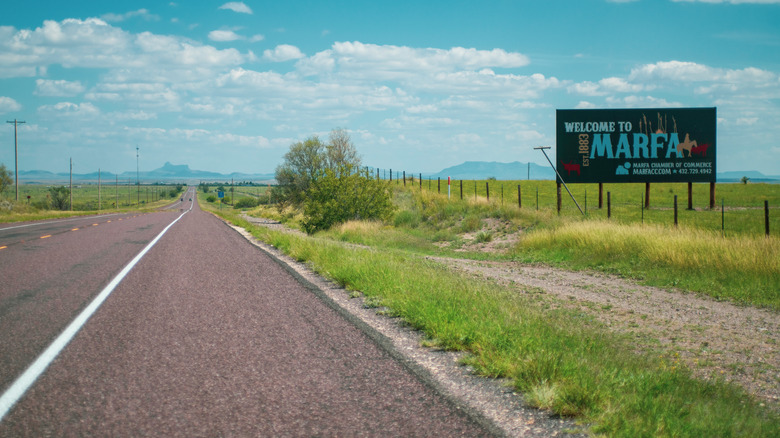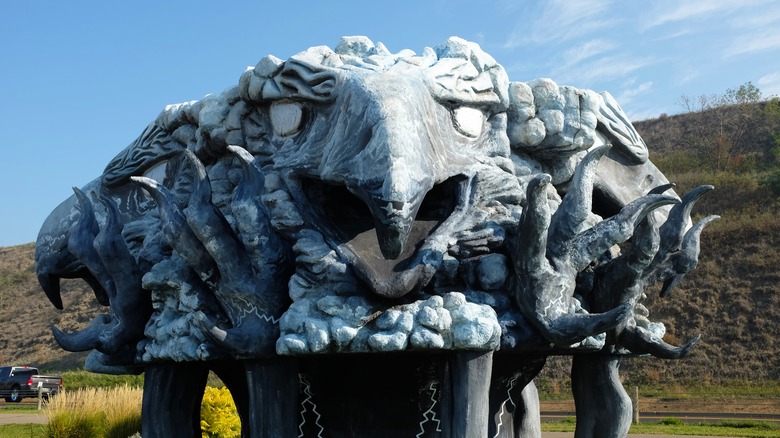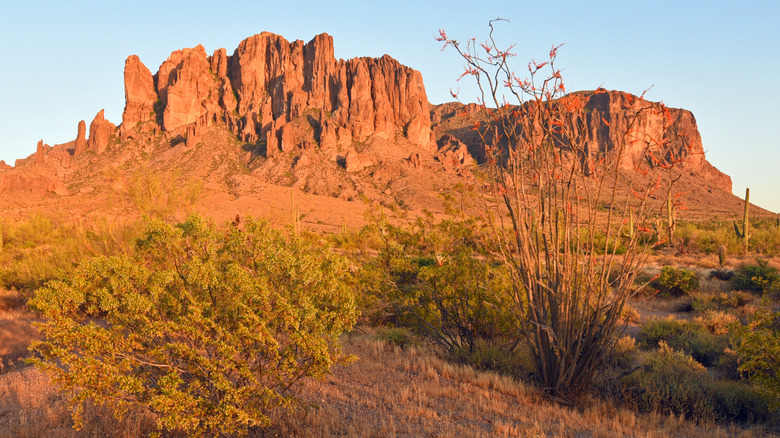The Most Bizarre Unsolved Mysteries Of The Wild West
Lost treasures. Unsolved murders. Disappearances. These stories continue to intrigue history lovers of the Old West. As the American frontier expanded in the 19th and early 20th centuries, pioneers flocked to the region seeking prosperity, freedom, and essentially the American dream. But the West was rife with lawlessness, with tales of gun-slinging outlaws marking its infamous past, along with bloody battles between white settlers and the Native Americans who owned and occupied the land.
With such an infamous history, it's no wonder the Wild West has provided a backdrop for legendary stories and mysteries. What are the origins of old mines full of gold? Was Billy the Kid really shot dead by Pat Garrett? What really happened to some of the Wild West's most notorious women? Even with today's technology and advancements in science, thanks to the passage of time, some of these mysteries may never be solved.
The Lost Cabin Gold Mine is guarded by skeletons
This story begins in the gold mining town of Jacksonville, Oregon (pictured). In 1853, writes Oregon historian Finn J.D. John, brothers James and Henry Wilson set out with a group of prospectors looking for gold. After one of the men was killed by rogue Native Americans, the Wilsons trudged on alone. They eventually found a valley surrounded by steep cliffs and built a cabin, and Henry discovered a nearby creek chock full of gold nuggets. With winter and the dangerous natives on their minds, the boys dug a rock-lined hole in the floor of the cabin, deposited their treasure, and covered it with two flat stones.
The brothers no sooner set out for civilization when the natives reappeared and killed Henry. James escaped to northern California. He was in very ill health, writing his cousin, Ted Harper, before dying. Fifteen years later, Harper and an alcoholic poet, Sam Simpson, went looking for the cabin. All they found were burned ruins with Henry's body inside, right as Harper allegedly accidentally shot himself and died! A shaken Simpson returned home sans the gold. Later that year, another group of men went looking for the mine, according to Crater Lake Foundation. They of course found nothing, but they did discover a national treasure – Crater Lake itself, the deepest known lake in America.
The mysterious duel of Alfred Schlesinger
In September 1876, the Colorado Daily Chieftain reported a most curious case – Dr. S.E. Solly, a prominent physician in Colorado Springs, Colo., said that he had received some mysterious letters from Alfred Schlesinger. At the time, the young man was employed by Colorado Springs and Denver & Rio Grande Railroad founder William Jackson Palmer. The British-born Schlesinger had been Palmer's private secretary since April. Schlesinger's letters explained that he had gone to participate in a "fight" at the Lawson Ranch some 15 miles away. If he did not return, Schlesinger wrote, Solly was to come find his body.
Sure enough, Solly and others went to the ranch and found Schlesinger laying face down in the dirt, with "a pistol by his side and a white pocket handkerchief." And a bullet hole through his heart. He was only 19 years old. A line was drawn in the dirt as if for a duel, but Schlesinger wrote that he had promised not to reveal his adversary for two years — if he lived. News of the death traveled as far away as Minnesota, and a reward was being gathered for the arrest of his killer, but all for naught. Schlesinger rests in Colorado Springs' Evergreen Cemetery today but is said to haunt two prominent landmarks from his time, Briarhurst Manor and Glen Eyrie.
Bigfoot in the Wild West
Modern-day Bigfoot tales aside, the big hairy guy has actually been alive and well since the 16th century, says Legends of America, when Native tribes reported seeing the great "Sasquatch." History says there are actually Bigfoot stories from all over the world. In the American west, various newspaper stories from the 1800s, according to Cowboys & Indians, "are brimming with giant wild men, [and] wood apes" who look and sound like the Bigfoot everyone has come to know and love. Oh yeah, and they stunk back then just like they are said to today. In Spokane, Wash., says Crosscut, they actually call Bigfoot the "Bad Smelling Tree Man."
The Oregon Encyclopedia says that ethnographer George Gibbs first started recording Native stories of Bigfoot in the state as early as 1865, although the first official record of sightings was not made until 1904 when one was seen around Sixes River on the southern coast. Bigfoot Field Researchers Organization (BFRO) started recording sightings in each state online in 1995. As of this writing, Washington state leads with 690, followed by California with 454, and Florida with 333. Colorado has only 129 recorded sightings, but enough have been reported to merit posting a warning sign on Pikes Peak, according to Woman's Day. If you happen to see a Bigfoot, you can report it on the BFRO site, which makes for fascinating reading.
The Spanish ship in the desert
In 1540, according to Desert Sun, Spanish explorer Hernando de Alarcón sailed up the Colorado River to today's Yuma, Ariz.. But did he make it further? Some 100 miles southeast around the Salton Sea, folks began reporting a Spanish ship stranded in the California desert. Desert USA wonders if it was actually a treasure ship piloted by a man named Iturbe, which was actually in the Salton when it was stranded by a mudslide. Around 1775 a mule driver for explorer Juan Bautista de Anza said he saw the vessel and even carried away some of the treasured pearls he found aboard.
Next, explorer Albert Evans claimed to have found "the wreck of a gallant ship" in 1870. Later that year Charley Clusker, says the Vintage News, also found the galleon — a story backed by Philadelphia's Evening Telegraph. Clusker later disappeared. Others doubt there is a ship – American Cowboy says one idea that a massive tidal wave stranded the ship is folklore, although others submit it could have really happened. One Lawrence Justus was so convinced the story was true that in 1974, he tried obtaining a permit from Anza-Borrego Desert State Park to look for it. Authorities refused the request, but a file at the park contains a picture of Justus, "who reportedly found the Lost Ship of the Desert."
The servant girl annihilator
Between 1885 and 1886, according to Austin Culture Map, eight ghastly murders in Austin, Texas, were attributed to a serial killer. Of the victims, most were "servant girls." Only one lived but her daughter, as well as the companion of another victim, were killed. PBS notes that six of the victims were Black. So were three women who were attacked in July, August, and November, says Servant Girl Murders, but they survived. Then Mollie Smith's axe-mutilated body was found next to an outhouse in December. The murders were quite grisly. In May 1885 another victim, Eliza Shelly, was found with her head "almost completely split." The killer was brutal, assaulting his victims with knives, axes, rocks, and even an iron.
According to KVUE, the writer O. Henry dubbed the murderer the "Servant Girl Annihilator," as Austin's Weekly Statesman commented, "The heart sickens at these repeated details of horrid, merciless crime." Next, Irene Cross, Clara Dick, and Rebecca Ramey and 11-year-old Mary Ramey were attacked. Only Rebecca survived. The next victims, according to the Fort Worth Daily Gazette, were Gracie Vance and her paramour, Orange Washington. Two more women who were not domestics, Sue Hancock and Eula Phillips, were murdered on Christmas Eve 1885. In February 1886, police killed Nathan Elgin, who was beating a saloon girl to death. The attacks stopped, but Elgin was never proven to be the Annihilator.
Belle Starr's murderer was never caught
On Feb. 3, 1889, says History, the notorious "Bandit Queen" was murdered by an unknown assailant in Oklahoma. Pryor to that time, the one-time good girl had gone through a string of bad men — outlaws Cole Younger, Jim Reed, Sam Starr, and Jim July, all of whom Belle Starr aided in horse-thieving and robbery. She even served time in prison, all while bearing children and living on the lam due to her various escapades. Legends of America notes that Belle's relationship with July was "particularly stormy," to the extent that the man once allegedly offered to pay someone to kill her. Still Belle remained faithful, accompanying July to Fort Smith, Arkansas, to answer charges of horse stealing. But then she inexplicably turned back.
The Dallas Morning News flamboyantly claims that as she traveled down a lonesome road towards home, Belle was "shot in the back over 60 times." Closer to the truth is History Net's story that Belle was shot only twice as her horse bolted home and alarmed her daughter, Pearl. Findagrave says she was taken home, dying an hour later, and was buried in her own front yard. Who killed her? The suspects ranged from July to a disgruntled neighbor named Watson to Belle's own son, Ed, or maybe even Pearl. Of these only Watson was tried but was found not guilty.
What happened to Albert and Henry Fountain?
Albert Jennings Fountain, according to Findagrave, was many things — an Army Lieutenant, attorney, newspaperman, and senator. Until his disappearance he was best-known as the trial lawyer for Billy the Kid, who lost his case. In 1896, Fountain and his young son, Henry, were in Lincoln, N.M., for the rustling case against cattle baron Oliver Lee, per Socorro County Cold Cases. Desert USA says author A.M. Gibson verified Fountain had many enemies at the trial, including Lee. No wonder Fountain "had the feeling of being closely watched" while in Lincoln. And after receiving a threatening note as the trial ended, the Fountains immediately started for home 150 miles away.
Two days later the pair disappeared, according to True West. Only Fountain's wagon was found, along with pools of blood, bullet shells, and Henry's handkerchief. Even famed sheriff Pat Garrett got involved, to no avail. Although Lee's hired hands were eventually tried, they were found not guilty. Two confessions came later — one by James Gilliland in 1937, and one in 1949 when convicted outlaw Sam Ketchum claimed on his deathbed that it was he and his brother, Tom "Black Jack" Ketchum, who killed the Fountains. But the bodies weren't where the men said they were. The Fountain case remains the most famous cold case in New Mexico history.
Black Jack Ketchum's hidden loot
Tom "Black Jack" Ketchum may not have killed Albert and Henry Fountain, but he was certainly found guilty of numerous robberies and murders before he was sentenced to hang in 1901, according to Legends of America. There are at least two stories about Ketchum stashing treasure in the years before he died. The first is that he "buried a large treasure" in Wild Cat Canyon in the Chiricahua Mountains of Arizona, according to Metal Detecting. More specifically, writes William Ascarza in his book "Chiricahua Mountains: History and Nature," Ketchum "stashed several thousand dollars" in a cave, which has been referred to as "Room Forty Four."
Payson historian Jinx Pyle offered a second story for Discover Gila County. A posse was chasing Ketchum following a robbery in Camp Verde when the outlaw lassoed himself and some $4,000 in stolen loot to a branch high up in a tree somewhere around Battle Ground Ridge. Four days later when the coast was clear, Ketchum came down and headed towards the Myrtle Ranch, possibly hiding his cache between there and Gilliland Gap. Neither stash has been found as far as anyone knows. Today Ketchum is best-remembered for his death by hanging in Clayton, New Mexico. The Vintage News reports that when the trapdoor swung open at the gallows the outlaw fell further than he should have, yanking his head clean off.
What really happened to Etta Place?
History buffs love debating about whether Butch Cassidy and the Sundance Kid really died in Bolivia. But the real mystery is what became of their companion, Etta Place. Not even Pinkerton's Detective Agency knew her real name, although they could describe her, according to Legends of America – "classic good looks, 27 or 28 years old, 5'4″ to 5'5″ in height, weighing between 110 and 115 pounds, with a medium build and brown hair." But that could be about any woman in the Edwardian era. Everything else about Place is purely speculation. Was she a schoolteacher? Or a harlot from a Texas bordello? Or maybe even Sundance's cousin, according to Criminal Element? Nobody knows for sure.
It is a fact that Place loved Sundance enough to accompany him and Cassidy to South America. For a couple of glorious years, according to True West, the trio "robbed numerous banks, and intercepted one mule train after another carrying gold and paper money." Although Place was supposedly killed along with her outlaw men by Bolivian soldiers, others point out that she was later seen back in America both with and without Sundance. Historian Anne Meadows, in her book 'Digging Up Butch and Sundance," maintains that Sundance took Place to San Francisco for a final time in 1905. She was also identified as the woman seeking "documents declaring Sundance dead" there in 1909. Whoever she was, Place took her secret to her grave.
The gruesome unsolved murder of madam May Prescott
In 1916 the Coconino Sun in Flagstaff, Arizona, reported a most chilling find — alerted by a terrible odor, authorities found the bodies of madam May Prescott and her husband Fred in a bedroom at their home. Fred's throat was slashed ear to ear. He'd been stabbed in the back and shot in the head. May's throat also was cut, and she had been shot twice. The blood-splattered, bullet-scarred bedroom had been set on fire. Fred also held a gun with one bullet fired and had left a note that he had violently quarreled with May before shooting her and then himself. How does a man with his throat cut wide open shoot himself in the head and set a fire?
For weeks, the coroner poured over tons of evidence. The jury finally concluded that the couple died from "knife and gunshot wounds caused by the hands of unknown party or parties." The case was never solved. Surprisingly, although a portion of the Prescott's home remains under the facade of today's Grand Canyon International Youth Hotel, it is not mentioned on Flagstaff Downtown's list of haunted locations. According to Quinta Scott's book, "Along Route 66," the house was purchased by K.J. Nackard soon after the murders, who actually lived in it and eventually built his Downtowner Auto Court around it.
The disappearance of Pearl Hart
A true wild child, Pearl Hart was a Canada native whom Annals of Crime says made it through finishing school before making a series of life mistakes. She was 17 when she was "seduced" by gambler Fred Hart, who remained in the girl's life until 1898. Tired of supporting her and two children, according to Legends of America, Fred beat her up and split. The next man in Pearl's life, Joe Boot, was her final undoing. The two embarked on a life of crime but were caught in 1899. Boot was sentenced to 30 years in prison (and later escaped), while Pearl got five years.
The public now took interest in the woman bandit who dressed like a man. In prison she not only signed autographs but also began spreading the gospel. Pearl was finally paroled — because she inexplicably became pregnant while in prison. Gov. Alexander Brodie pardoned her in 1902, says Spartacus Educational. What happened to her? It's hard to say. The Vintage News says she tried performing onstage as a "Lady Bandit" before being arrested in Kansas City for buying stolen goods. She was arrested again in 1904, after which she wasn't seen again until 1924 in Florence, Arizona. Various sources say she died in 1925, or sometime in the 1950s, or even as late as the 1960s. But nobody knows for sure.
Where are Kate Arnold's ashes?
When it opened for business in 1893, according to Legends of America, the elite Sheridan Inn in Sheridan, Wyoming, even offered electricity. Showman "Buffalo Bill" Cody was on hand at the grand opening and actually purchased the hotel a year later. His selling of the hotel in 1901 coincided with the hiring of Catherine "Miss Kate" Arnold, just in from her native Virginia, according to the Sheridan Inn. By the 1910 census Arnold had moved into the inn, where she worked as a seamstress, "desk clerk, housekeeper, hostess and sitter for the many children who stayed at the Inn with their families." And she loved her job.
During her time at the Inn, Arnold met such famous guests as Ernest Hemingway, President Herbert Hoover, Bob Hope, and Will Rogers. Only in Your State says Annie Oakley stayed there too. Amazingly, Arnold remained in the Sheridan's employ until 1965, when the building was to be torn down. But the Sheridan Historical Society was able to save it, and when Arnold died in 1968, she requested her ashes to be interred in the wall of her room, 306, on the third floor. Following a "small ceremony" in the room, her ashes were interred in the wall. Funny thing is, today nobody seems to know exactly where in the wall the ashes are. Cowboys and Indians maintains that Arnold's spirit is ever present, and guests enjoy staying in her room.
What fell from the sky near Aurora, Texas?
As the legend goes — and as published in the April 17, 1897 edition of The Dallas Morning News — an odd craft described as an airship struck a windmill near the little town of Aurora, Texas. The pilot was killed, but his remains were intact enough to indicate that he was not human.
Local merchant S.E. Haydon may have created the story in an attempt to capitalize on UFOs that had been recently sighted around Fort Worth. His motive was supposedly to revitalize Aurora, which had been hard-hit by disease and a lack of railroad access. If that's the case, Haydon's effort didn't do much, as the town struggled along until a state highway came through in 1939. Now, it's doing fine as a suburb of Fort Worth that doesn't mind capitalizing on the maybe-true story of an extraterrestrial visitor.
But there is a lingering issue, at least for some. That would be the otherworldly pilot's gravesite, where the oddly proportioned remains were allegedly given a Christian burial. The original gravestone has disappeared, but people still leave flowers, plastic toys, and other trinkets where they believe the ship's occupant still rests. Ground penetrating radar shows that something may be there, but the report of a Christian burial means the next-of-kin has to give permission for the grave to be dug up. With no records and next-of-kin that might just be on another planet, this mystery will have to linger for a while longer.
Where is Cochise buried?
By the middle of the 19th century, Chiricahua Apache chief Cochise had established himself as an important leader in what's now Arizona, as well as a fierce adversary of the U.S. government in the Apache Wars. This conflict continued into the 1870s and often involved guerilla warfare that favored Indigenous knowledge of the mountainous desert landscape. Eventually, however, Cochise agreed to an 1872 peace treaty and went to live on the Chiricahua Reservation until he died in 1874.
Despite the acclaim and his historic significance, the location of Cochise's grave remains a secret to this day. The only white person who reportedly knew of the burial was former U.S. Army scout and Chiricahua reservation agent Tom Jeffords. Sympathetic to the struggle of the Chiricahua, Jeffords allowed Indigenous people to freely move about within and off the reservation. Cochise eventually grew close with Jeffords, and it's believed that he was the only white man Cochise ever truly befriended.
You can't really blame the Chiricahua people for keeping their leader's final resting place a secret, given that after Cochise's death, the U.S. swiftly moved to shut down the reservation and fire Jeffords in favor of a far less friendly agent. It's easy to see how government representatives might have desecrated the grave and therefore why the small group who knew of its location kept their mouths shut. Of the many Wild West mysteries out there, this surely qualifies as one that is best left alone.
Billy the Kid's true fate
On April 28, 1881, Billy the Kid was awaiting execution for committing murder, then dramatically escaped jail in Mesilla, New Mexico, killing two sheriff's deputies in the process and leading to Sheriff Pat Garrett tracking Billy through New Mexico. While Garrett was questioning an associate of the outlaw, Billy unexpectedly walked into the dark room. Garrett quickly pulled his gun and shot the young man dead.
Many have since claimed that Garrett made a grave mistake and killed someone else, including multiple people who have been identified as Billy the Kid himself. The most notorious may be the grizzled old man who went by Ollie "Brushy Bill" Roberts. In 1948, Brushy Bill was living in Hico, Texas, where he confessed to a researcher that he was the notorious outlaw. Roberts even attempted to get a pardon for his supposed crimes as Billy the Kid, but he died in December 1950 before anything came of it.
Further complicating things is a 1904 flood that washed away the marker over the "real" Billy's New Mexico grave. Afterward, even people who attended the burial couldn't remember exactly where he had been laid to rest. The grave of Billy's mother, Catherine Antrim, is known, but requests to open it and get a DNA sample have been denied. Attempts to exhume Brushy Bill haven't panned out either, with local officials nixing any attempts due to confusion over where Roberts' grave lies and serious doubts about his claim.
Where did the Bloody Benders go?
At first sight, the landscape around what would be Cherryvale, Kansas, must have seemed quiet, if tragic. By 1870, the American Civil War had nearly torn apart the newly minted state and the wider nation, while the local Osage people experienced their own sorrows when they were forcibly relocated to Oklahoma.
The first of the Benders — though no one knows for sure if that was their real name, or even if they were a family — arrived there in October 1870. The two men went by John Bender Sr. and John Bender Jr. Pa, as the irascible elder man was known, appeared to be a German immigrant with little command of English. His wife Elvira, the notoriously rude Ma, didn't speak much English, either. John Jr. was more fluent, but his odd mannerisms led others to believe he wasn't fully there. However, the daughter, Kate, drew attention both for her good looks and spooky, spirit-communicating ways.
Then, the disappearances started to happen, with many apparently linked to the Bender cabin that did double duty as a rundown inn for travelers. The Benders skipped town before locals descended upon their land and discovered the gruesome remains of many unfortunates buried on the property. A frantic search ensued, but apart from a scattering of unconfirmed sightings — multiple pairs of women were accused of being Ma and Kate, while others claimed to track the family into Indian Territory before losing the group — the Bloody Benders disappeared into history.
Is the St. James Hotel really haunted?
For anyone who harbors even a slight belief in ghosts and an interest in the Wild West, the St. James Hotel is ripe for consideration. Located in Cimarron, New Mexico, it opened in 1872 as Lambert's Inn. It was a nice enough spot for weary travelers on the Santa Fe Trail, but it could also prove deadly. Contentious poker players were known to shoot each other there, lending a possible explanation for the paranormal goings-on that are said to happen in the hotel today (and all those bullet holes in the ceiling). Its original proprietor, Henry Lambert, experienced his own share of tragedy. He was once President Abraham Lincoln's chef, though the Lincoln assassination effectively ended his employment, pushing Lambert to move west.
Many adventurers and fortune-hunters made their way to Lambert's hotel, including Buffalo Bill Cody, Wyatt Earp, Black Jack Ketchum, and Billy the Kid. With the arrival of the railroads, traffic on the Santa Fe Trail died down and so, too, nearly did the St. James. It thankfully survived and has been updated, allowing new guests to ponder mysterious reports of phantom cowboys and disembodied footsteps there.
The most colorful ghost story here may be that of Thomas James Wright, who was shot after winning a poker game and stumbled into his room to die. This room is kept locked because Wright's spirit is said to push people down, appear as a strange light, and has even been rumored to cause deaths.
Pancho Villa's head is still missing
Pancho Villa had a tough start in life, becoming an orphan at a young age and, after killing a man who attacked his sister, a renegade. By 1910, he had made a name for himself as a highly skilled rebel fighter who faced off against Mexican dictators. He briefly enjoyed acclaim as a revolutionary in 1914, but soon ran afoul of authorities, fled to mountainous northern Mexico, and violently attacked Mexican and American communities. Despite drawing the ire of both the U.S. and Mexican governments, Villa continued to evade capture. He was eventually pardoned and then assassinated in 1923.
Villa's story doesn't end with his death. In 1926, vandals broke into his grave. Caretaker Juan Amparan reported that the body had been damaged and, even worse, Villa's head was missing. Suspicion eventually settled on American soldier and treasure hunter Emil Lewis Holmdahl, who had once helped the U.S. Army search for Villa. But when Holmdahl was arrested and his belongings searched, Villa's head was nowhere to be found. Later reports claimed that Holmdahl had gotten drunk and shown a friend the head, saying that he'd been commissioned to steal it by an unknown buyer.
Some rumormongers claim that Villa's head made it all the way to New Haven, Connecticut, where it joined a morbid skull collection maintained by the Skull and Bones secret society at Yale University. However, none of these stories have been proven, and, officially at least, Villa's head remains missing.
Who built the Loretto Chapel staircase?
The Loretto Chapel staircase in Santa Fe, New Mexico, is a supremely lovely structure, with a unique double spiral twisting up 22 feet into the choir loft. But the small chapel opened in 1878 without any stairs at all, so carpenters told the nuns who used the space that they would have to use a ladder. The sisters reportedly undertook a nine-day-long series of prayers called a novena dedicated to St. Joseph, patron of craftspeople. As the prayers were winding down, an itinerant carpenter appeared, looking for work. He proceeded to craft the staircase before disappearing without accepting pay. When a search didn't turn up any information, the sisters and other locals wondered if it was St. Joseph himself.
Even skeptics admit that whoever made the chapel staircase was a master carpenter. However, it isn't a miracle that holds it up but the skillful use of math, wooden pegs, and what must have been many years of experience.
But whose experience? Researcher Mary J. Straw Cook believes she's found proof that French carpenter Francois-Jean Rochas constructed the staircase (via Santa Fe New Mexican). Rochas, who also went by Frenchy and Frank, made his way to New Mexico in the late 19th century, established himself as a hardworking but supremely introverted man, and was reportedly murdered in his home by a mysterious group of three men.
Was the Victorio Peak Treasure stolen?
New Mexico's Victorio Peak was already notorious before the treasure reared its head. Chiricahua Apache leader Victorio is believed to have used the spot while facing off with the U.S. Army, including an 1880 fight there between Victorio's forces and Buffalo Soldiers from the Ninth Cavalry.
Flash forward to late 1937, when hunter Milton "Doc" Noss reportedly stumbled across what he thought was an abandoned mine. Descending into the shaft, he entered a cave with a series of small chambers that included dozens of skeletal human remains, documents from the 19th century, and a glittering treasure hoard full of money, jewels, and solid gold bars (some of which he buried in the desert). When word of the find got out, some speculated that Noss had found a stash of Spanish conquistador loot, stolen treasure from Mexico's Emperor Maxmillian, or valuables hidden away by Victorio. Just two years after the initial discovery, careless use of dynamite collapsed the entrance.
Eventually, the military moved in and made it all but impossible for Noss' widow, Ova, to keep excavating the claim. Some have since claimed that the U.S. government quietly re-entered the cavern and took the treasure for its own purposes. But, it's also worth noting that Noss never provided clear evidence to support his tale and exhibited signs of alcoholism and paranoia. Anyone who tries to visit the site today will likely have military personnel escort them off what's now the White Sands Missile Range.
Some people still aren't sure about the Marfa Lights
What makes the lights of Marfa, Texas, so intriguing isn't their appearance so much as how long they've been showing up in the desert around this west Texas town. The first recorded sighting is from 1883, when cattle driver Robert Reed Ellison spotted a single light while moving a herd through the Paisano Pass. Reed thought it might be a campfire, but no one found evidence of a campsite and others told him that they'd often seen the strange lights, too. Since then, generations of residents and visitors claim to have seen the lights. Reports typically describe basketball-sized lights that float a few feet off the ground. Most are white, and they're only visible at night.
More grounded explanations focus on car headlights, which could refract through the rapidly heating and cooling desert air. What about the 19th-century reports? Brian Dunning of Skeptoid notes that Ellison's pre-automobile report was actually a story he only told orally and failed to write down. It only became public in the 20th century. Studying the phenomenon in 2004, the Society of Physics Students found strong evidence that the lights moved in concert with traffic on a nearby highway.
If all of that sounds like a major buzzkill, you can put stock into mysterious tales of lights hovering directly above or around a person, or even leading lost folks to safety in poor weather. Perhaps that's enough to hold out hope for the mystery.
What the heck is the thunderbird?
Do a search for the thunderbird and chances are good that you'll come across an alarming photo. The black and white picture, supposedly from 19th-century Arizona, shows a group of men supporting what seems to be a pterodactyl with a considerable wingspan. Some sources claim that this is evidence of the Tombstone thunderbird, a flying creature that was taken down near Tombstone, Arizona, sometime in 1890. Depending on the account you read, its wingspan was anywhere from 20 to 160 feet, and it was shot down by a pair of cowboys who somehow managed to drag the massive carcass into town.
A small amount of further research indicates that this particular story is likely nonsense that's crafted from foggy recollections, tall tales, and outright fiction. Frankly, if you have even a passing familiarity with digital photo manipulation, the Tombstone Thunderbird photograph looks awfully fake.
It's harder to brush off the stories of the thunderbird told by Native Americans, however. Many tribes share legends of a massive, powerful bird that is associated with rainstorms both helpful and destructive. It's mentioned by tribes of the Great Plains, people of the Great Lakes, and those living in the forested Northeast. In the Pacific Northwest, some Indigenous legends claim that the thunderbird can even pick up a whale in its mighty talons, a tale researchers suggest was used to explain earthquakes and other seismic events in the region. Maybe there's something to the legends, after all.
Where is the Lost Dutchman Mine?
It all started in the Superstition Mountains east of Phoenix, Arizona. Conquistador Francisco Coronado is believed to have torn through the region in the 16th century on his search for the mythical Seven Cities of Gold. Though the Spaniards never found gold, later explorers did find valuable ore deposits in the Superstitions — and plenty of trouble via war, betrayal, and the Apache.
In the 1870s, German immigrant Jacob Waltz made his way to the area. By 1877, he was reportedly buying up supplies with suspiciously fine gold ore, but Waltz never gave anyone a straight answer regarding the gold's origins. When he nearly died in a flood and then contracted pneumonia, he gave his caretakers hints of a golden hoard in the mountains. Or did he simply experience slowly declining health and die in Phoenix, as some accounts maintain? Either way, when Waltz died in 1891, the mystery of where he got the riches grew into the legend of the Lost Dutchman Mine (Dutch and German were often confused for each other in the Old West).
Since then, many have attempted to find the mine but with no apparent success and quite a few deaths. Some have speculated that the whole tale is made up or that it was confused with already-established mines. But perhaps, as some still hope, the Lost Dutchman Mine is still waiting out there in the Arizona desert.
